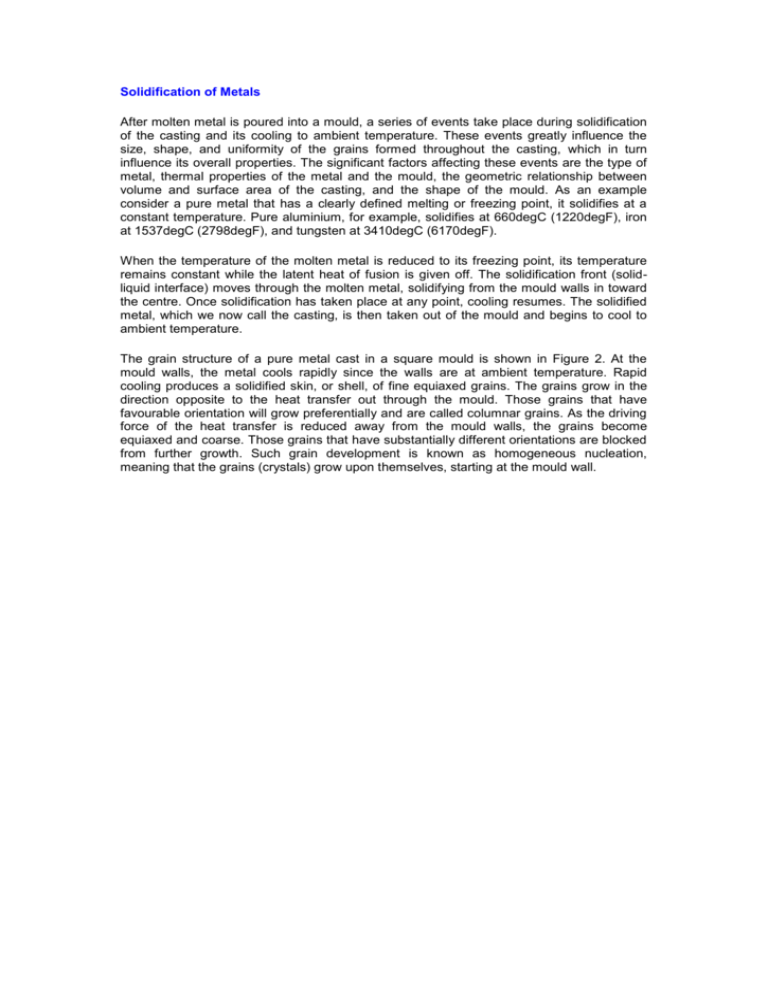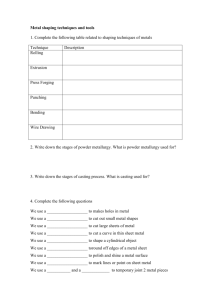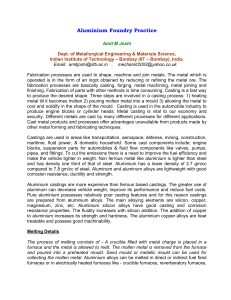Solidification of Metals
advertisement

Solidification of Metals After molten metal is poured into a mould, a series of events take place during solidification of the casting and its cooling to ambient temperature. These events greatly influence the size, shape, and uniformity of the grains formed throughout the casting, which in turn influence its overall properties. The significant factors affecting these events are the type of metal, thermal properties of the metal and the mould, the geometric relationship between volume and surface area of the casting, and the shape of the mould. As an example consider a pure metal that has a clearly defined melting or freezing point, it solidifies at a constant temperature. Pure aluminium, for example, solidifies at 660degC (1220degF), iron at 1537degC (2798degF), and tungsten at 3410degC (6170degF). When the temperature of the molten metal is reduced to its freezing point, its temperature remains constant while the latent heat of fusion is given off. The solidification front (solidliquid interface) moves through the molten metal, solidifying from the mould walls in toward the centre. Once solidification has taken place at any point, cooling resumes. The solidified metal, which we now call the casting, is then taken out of the mould and begins to cool to ambient temperature. The grain structure of a pure metal cast in a square mould is shown in Figure 2. At the mould walls, the metal cools rapidly since the walls are at ambient temperature. Rapid cooling produces a solidified skin, or shell, of fine equiaxed grains. The grains grow in the direction opposite to the heat transfer out through the mould. Those grains that have favourable orientation will grow preferentially and are called columnar grains. As the driving force of the heat transfer is reduced away from the mould walls, the grains become equiaxed and coarse. Those grains that have substantially different orientations are blocked from further growth. Such grain development is known as homogeneous nucleation, meaning that the grains (crystals) grow upon themselves, starting at the mould wall. FIGURE 2 Schematic illustration of the cast structure of a pure metal solidified in a square mould Shrinkage Because of their thermal expansion characteristics, metals shrink (contract) during solidification and cooling. Shrinkage, which causes dimensional changes - and, sometimes, cracking - is the result of:a. Contraction of the molten metal as it cools prior to its solidification, b. Contraction of the metal during phase change from liquid to solid (latent heat of fusion); and c. Contraction of the solidified metal (the casting) as its temperature drops to ambient temperature. The largest amount of shrinkage occurs during cooling of the casting. Casting Defects Various defects can occur in manufacturing processes, depending on factors such as materials, part design, and processing techniques. While some defects affect only the appearance of parts, others can have major adverse effects on the structural integrity of parts made. Several defects can develop in castings [ Figures 3 and 4 ] :- FIGURE 3 Examples of hot tears in castings. These defects occur because the casting cannot shrink freely during cooling, owing to constraints in various portions of the moulds and cores. Exothermic (heat producting) compounds may be used (exothermic padding) to control cooling at critical sections to avoid hot tearing. Metallic projections, consisting of fins, flash, or massive projections. Cavities, consisting of rounded or rough internal or exposed cavities, including blowholes, pinholes, and shrinkage cavities (see porosity below). Discontinuities, such as cracks, cold or hot tearing, and cold shuts. If the solidifying metal is constrained from shrinking freely, cracking and tearing can occur. Although many factors are involved in tearing, coarse grain size and the presence of low-melting segregates along the grain boundaries (intergranular) increase the tendency for hot tearing. Incomplete castings result from the molten metal being at too low a temperature or pouring the metal too slowly. Cold shut is an interface in a casting that lacks complete fusion because of the meeting of two streams of liquid metal from different gates. Defective surface, such as folds, laps, scars, adhering sand layers, and oxide scale. Incomplete casting, such as misruns (due to premature solidification), insufficient volume of metal poured, and runout (due to loss of metal from mould after pouring). Incorrect dimensions or shape, owing to factors such as improper shrinkage allowance, pattern mounting error, irregular contraction, deformed pattern, or warped casting. Inclusions, which form during melting, solidification, and moulding. Generally non-metallic, they are regarded as harmful because they act like stress raisers and reduce the strength of the casting. They can be filtered out during processing of the molten metal. Inclusions may form during melting because of reaction of the molten metal with the environment (usually oxygen) or the crucible material. Chemical reactions among components in the molten metal may produce inclusions; slags and other foreign material entrapped in the molten metal also become inclusions. Reactions between the metal and the mould material may produce inclusions. Spalling of the mould and core surfaces also produces inclusions, indicating the importance of the quality and maintenance of moulds FIGURE 4 Examples of common defects in castings. These defects can be minimised or eliminated by proper design and preparation of moulds and controlof pouring procedures Porosity Porosity in a casting may be caused by shrinkage or gases, or both. Porosity is detrimental to the ductility of a casting and its surface finish, making it permeable and thus affecting pressure tightness of a cast pressure vessel. Porous regions can develop in castings because of shrinkage of the solidified metal. Thin sections in a casting solidify sooner than thicker regions. As a result, molten metal cannot be fed into the thicker regions that have not yet solidified. Because of contraction, as the surfaces of the thicker region begin to solidify, porous regions develop at their centres. Microporosity can also develop when the liquid metal solidifies and shrinks between dendrites and between dendrite branches.








